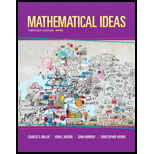
Mathematical Ideas (13th Edition) - Standalone book
13th Edition
ISBN: 9780321977076
Author: Charles D. Miller, Vern E. Heeren, John Hornsby, Christopher Heeren
Publisher: PEARSON
expand_more
expand_more
format_list_bulleted
Question
Chapter 15.2, Problem 14E
(a)
To determine
To prove: Whether candidate ‘a’ wins the election from provided candidates by using plurality method.
(b)
To determine
Winner in the second plurality method election after removing candidate c from provided candidates.
(c)
To determine
Whether the plurality method violates the irrelevant alternatives criteria in selection process.
Expert Solution & Answer
Want to see the full answer?
Check out a sample textbook solution
Students have asked these similar questions
Using the plurality-with-elimination method, who wins the election if candidate E is removed from the ballot?
What method of voting is described below?A single-winner electoral system where each voter may select any number of candidates. The winner is the most-approved candidate.
a
Plurality with elimination
b
Two-round runoff
c
Ranked choice
d
Approval
# of votes
2
2
1
3
First
A
B
B
A
Second
B
C
D
B
Third
C
D
C
D
Fourth
D
A
A
C
suppose the borda count method was used to determine the winner. Determine wether the majority criterion is satisfied. Yes or no
Chapter 15 Solutions
Mathematical Ideas (13th Edition) - Standalone book
Ch. 15.1 - Choosing a Poster Dog by the Plurality Method A...Ch. 15.1 - Choosing a Poster Dog by the Plurality Method A...Ch. 15.1 - Choosing a Poster Dog by Alternative Methods For...Ch. 15.1 - Choosing a Poster Dog by Alternative MethodsFor...Ch. 15.1 - Observing the Effect of the Number of Candidates...Ch. 15.1 - Observing the Effect of the Number of Candidates...Ch. 15.1 - Observing the Effect of the Number of Candidates...Ch. 15.1 - Observing the Effect of the Number of Candidates...Ch. 15.1 - Observing the Effect of the Number of Candidates...Ch. 15.1 - Observing the Effect of the Number of Candidates...
Ch. 15.1 - Applying Four Voting Methods to a Voter Profile...Ch. 15.1 - Applying Four Voting Methods to a Voter Profile...Ch. 15.1 - Applying Four Voting Methods to a Voter Profile...Ch. 15.1 - Applying Four Voting Methods to a Voter Profile...Ch. 15.1 - Applying Four Voting Methods to a Voter Profile...Ch. 15.1 - Applying Four Voting Methods to a Voter Profile...Ch. 15.1 - Applying Four Voting Methods to a Voter Profile...Ch. 15.1 - Applying Four Voting Methods to a Voter Profile...Ch. 15.1 - Holding a Runoff Election One common solution to...Ch. 15.1 - Prob. 20ECh. 15.1 - Prob. 21ECh. 15.1 - Prob. 22ECh. 15.1 - Prob. 23ECh. 15.1 - Prob. 24ECh. 15.1 - Prob. 25ECh. 15.1 - Prob. 26ECh. 15.1 - Prob. 27ECh. 15.1 - The Pairwise Comparison Method Each table...Ch. 15.1 - Prob. 29ECh. 15.1 - Prob. 30ECh. 15.1 - The Borda Method Each table represents a Borda...Ch. 15.1 - Prob. 32ECh. 15.1 - Prob. 33ECh. 15.1 - Prob. 34ECh. 15.1 - Prob. 35ECh. 15.1 - Prob. 36ECh. 15.1 - The Coombs Method The Coombs method of voting is a...Ch. 15.1 - Prob. 38ECh. 15.1 - Prob. 39ECh. 15.1 - Prob. 40ECh. 15.2 - Identifying Violations of the Majority Criterion...Ch. 15.2 - Identifying Violations of the Majority Criterion...Ch. 15.2 - Identifying Violations of the Majority...Ch. 15.2 - Identifying Violations of the Majority Criterion...Ch. 15.2 - Identifying Violations of the Condorcet...Ch. 15.2 - Identifying Violations of the Condorcet Criterion...Ch. 15.2 - Identifying Violations of the Condorcet Criterion...Ch. 15.2 - Identifying Violations of the Condorcet Criterion...Ch. 15.2 - Prob. 9ECh. 15.2 - Prob. 10ECh. 15.2 - Prob. 11ECh. 15.2 - Prob. 12ECh. 15.2 - Prob. 13ECh. 15.2 - Prob. 14ECh. 15.2 - Prob. 15ECh. 15.2 - Prob. 16ECh. 15.2 - Prob. 17ECh. 15.2 - Prob. 18ECh. 15.2 - Prob. 19ECh. 15.2 - Irrelevant Alternatives in a Hare Method Election...Ch. 15.2 - 21. Explain why a violation of the majority...Ch. 15.2 - Prob. 22ECh. 15.2 - Prob. 23ECh. 15.2 - Prob. 24ECh. 15.2 - Prob. 25ECh. 15.2 - Prob. 26ECh. 15.2 - Prob. 27ECh. 15.2 - Prob. 28ECh. 15.2 - Prob. 29ECh. 15.2 - Prob. 30ECh. 15.2 - Prob. 31ECh. 15.2 - Prob. 32ECh. 15.2 - Prob. 33ECh. 15.2 - Prob. 34ECh. 15.3 - Find each quantity (to the nearest whole number)...Ch. 15.3 - Find each quantity (to the nearest whole number)...Ch. 15.3 - Find each quantity (to the nearest whole number)...Ch. 15.3 - Find each quantity (to the nearest whole number)...Ch. 15.3 - Solve each problem.
5. New Trees for Wisconsin...Ch. 15.3 - Apportioning Computers to Schools Enrollments for...Ch. 15.3 - Assigning Faculty to Courses The English...Ch. 15.3 - 8. Apportioning Sailboats to Resorts The number of...Ch. 15.3 - Prob. 9ECh. 15.3 - 10. Show that the Webster method apportionment of...Ch. 15.3 - Prob. 11ECh. 15.3 - Prob. 12ECh. 15.3 - Prob. 13ECh. 15.3 - Prob. 14ECh. 15.3 - Prob. 15ECh. 15.3 - Find the Huntington-Hill cutoff point for rounding...Ch. 15.3 - Creating a Profile of School Bus Riders Create a...Ch. 15.3 - Prob. 18ECh. 15.3 - Prob. 19ECh. 15.3 - Prob. 20ECh. 15.3 - The standard quotas rounded up to the nearest...Ch. 15.3 - Prob. 22ECh. 15.3 - Prob. 23ECh. 15.3 - Prob. 24ECh. 15.4 - Quota Rule Violations with the Jefferson Method In...Ch. 15.4 - Quota Rule Violations with the Jefferson Method In...Ch. 15.4 - Quota Rule Violations with the Jefferson Method In...Ch. 15.4 - Quota Rule Violations with the Jefferson Method In...Ch. 15.4 - Alabama Paradox with the Hamilton Method In each...Ch. 15.4 - Alabama Paradox with the Hamilton Method In each...Ch. 15.4 - Alabama Paradox with the Hamilton Method In each...Ch. 15.4 - Alabama Paradox with the Hamilton Method In each...Ch. 15.4 - Population Paradox with the Hamilton Method In...Ch. 15.4 - Population Paradox with the Hamilton Method In...Ch. 15.4 - Population Paradox with the Hamilton Method In...Ch. 15.4 - Population Paradox with the Hamilton Method In...Ch. 15.4 - New States Paradox with the Hamilton Method In...Ch. 15.4 - New States Paradox with the Hamilton Method In...Ch. 15.4 - New States Paradox with the Hamilton Method In...Ch. 15.4 - New States Paradox with the Hamilton Method In...Ch. 15.4 - Violations of the Quota Rule? For each...Ch. 15.4 - Violations of the Quota Rule? For each...Ch. 15.4 - Violations of the Quota Rule? For each...Ch. 15.4 - Prob. 20ECh. 15.4 - Prob. 21ECh. 15.4 - Prob. 22ECh. 15.4 - Prob. 23ECh. 15.4 - Prob. 24ECh. 15.4 - Prob. 25ECh. 15.4 - 26. The Jefferson and Adams methods are both...Ch. 15 - How many different complete rankings are possible...Ch. 15 - Prob. 2TCh. 15 - Prob. 3TCh. 15 - Prob. 4TCh. 15 - Prob. 5TCh. 15 - Why is the irrelevant alternatives criterion an...Ch. 15 - Prob. 7TCh. 15 - Prob. 8TCh. 15 - Prob. 9TCh. 15 - Prob. 10TCh. 15 - Prob. 11TCh. 15 - Prob. 12TCh. 15 - Prob. 13TCh. 15 - Prob. 14TCh. 15 - Prob. 15TCh. 15 - Prob. 16TCh. 15 - Prob. 17TCh. 15 - Prob. 18TCh. 15 - Prob. 19TCh. 15 - Prob. 20TCh. 15 - Prob. 21TCh. 15 - Prob. 22TCh. 15 - Prob. 23TCh. 15 - Prob. 24TCh. 15 - Prob. 25TCh. 15 - One hundred seats are to be apportioned to 4...Ch. 15 - Prob. 27TCh. 15 - Prob. 28TCh. 15 - Prob. 29TCh. 15 - Explain the Alabama paradox.Ch. 15 - Prob. 31TCh. 15 - Prob. 32T
Knowledge Booster
Learn more about
Need a deep-dive on the concept behind this application? Look no further. Learn more about this topic, subject and related others by exploring similar questions and additional content below.Similar questions
- # of votes 7 5 6 1st A B C 2nd B C B 3rd C A A Suppose the plurality method was used on this table. If B drops out is the irrelevant alternative criterion satisfied? Yes or noarrow_forwardThe Mathematics Department is holding an election for department chair. Each member ranks the candidates from first to third. The preference table below shows the results of the ballots with candidates Clark (C), Jones (J), and Smith (S). Number of Votes 7 10 4 8 First J S J C Second S J C S Third C C S J If the plurality method is used to determine the winner and Clark drops out, is the irrelevant alternatives criterion satisfied? Yes Noarrow_forwardUsing the Plurality method of voting, what project should be implemented by the local advocacy group? G E W P 2. Using the Pairwise comparison method of voting, which of the following fairness in voting will NOT be violated? a. Majority criterion b. Condorcet criterion and Independence of irrelevant alternatives criterion c. Monotonicity criterion d. None of the above. 3. Suppose that 57 people who voted for water conservation (W) first and promoting local business (P) second changed their votes such that they all voted for promoting local business (P) first and water conservation (W) second. Which project will win using the Borda count method of voting? G E W Parrow_forward
- A student organization at Penn State is voting to pass its budget. Susan has 6 votes as the President, Joe has 4 votes as the Vice-President, Carol has 2 votes as an assistant and Margo has 1 vote as a committee member. At least 8 of the 13 votes are needed to pass a resolution. How is the weighted voting system represented mathematically? Group of answer choices [8: 6, 2, 1, 1] [13: 8, 4, 3, 2, 1 ] [13: 6, 4, 2, 1] [8: 6, 4, 2, 1]arrow_forwardThe managers of Prints Alive (a local silk-screening business) are planning a party for their 30 employees. There are three possible locations for the party: the warehouse (W), the park (P), or the beach (B). The employees are asked to rank these choices in order of preference, and the results are summarized in the table. Use the instant runoff method to determine the winner. the parkthe beach the warehouse Number of Ballots Cast 2 12 13 3 1st choice P P B W 2nd choice B W W B 3rd choice W B P Parrow_forwardUsing the plurality with elimination method, which choice wins this election?arrow_forward
arrow_back_ios
arrow_forward_ios
Recommended textbooks for you
 Discrete Mathematics and Its Applications ( 8th I...MathISBN:9781259676512Author:Kenneth H RosenPublisher:McGraw-Hill Education
Discrete Mathematics and Its Applications ( 8th I...MathISBN:9781259676512Author:Kenneth H RosenPublisher:McGraw-Hill Education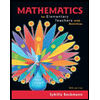 Mathematics for Elementary Teachers with Activiti...MathISBN:9780134392790Author:Beckmann, SybillaPublisher:PEARSON
Mathematics for Elementary Teachers with Activiti...MathISBN:9780134392790Author:Beckmann, SybillaPublisher:PEARSON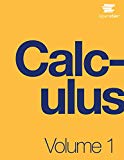
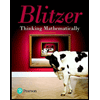 Thinking Mathematically (7th Edition)MathISBN:9780134683713Author:Robert F. BlitzerPublisher:PEARSON
Thinking Mathematically (7th Edition)MathISBN:9780134683713Author:Robert F. BlitzerPublisher:PEARSON Discrete Mathematics With ApplicationsMathISBN:9781337694193Author:EPP, Susanna S.Publisher:Cengage Learning,
Discrete Mathematics With ApplicationsMathISBN:9781337694193Author:EPP, Susanna S.Publisher:Cengage Learning,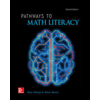 Pathways To Math Literacy (looseleaf)MathISBN:9781259985607Author:David Sobecki Professor, Brian A. MercerPublisher:McGraw-Hill Education
Pathways To Math Literacy (looseleaf)MathISBN:9781259985607Author:David Sobecki Professor, Brian A. MercerPublisher:McGraw-Hill Education

Discrete Mathematics and Its Applications ( 8th I...
Math
ISBN:9781259676512
Author:Kenneth H Rosen
Publisher:McGraw-Hill Education

Mathematics for Elementary Teachers with Activiti...
Math
ISBN:9780134392790
Author:Beckmann, Sybilla
Publisher:PEARSON


Thinking Mathematically (7th Edition)
Math
ISBN:9780134683713
Author:Robert F. Blitzer
Publisher:PEARSON

Discrete Mathematics With Applications
Math
ISBN:9781337694193
Author:EPP, Susanna S.
Publisher:Cengage Learning,

Pathways To Math Literacy (looseleaf)
Math
ISBN:9781259985607
Author:David Sobecki Professor, Brian A. Mercer
Publisher:McGraw-Hill Education
Chi Square test; Author: Vectors Academy;https://www.youtube.com/watch?v=f53nXHoMXx4;License: Standard YouTube License, CC-BY